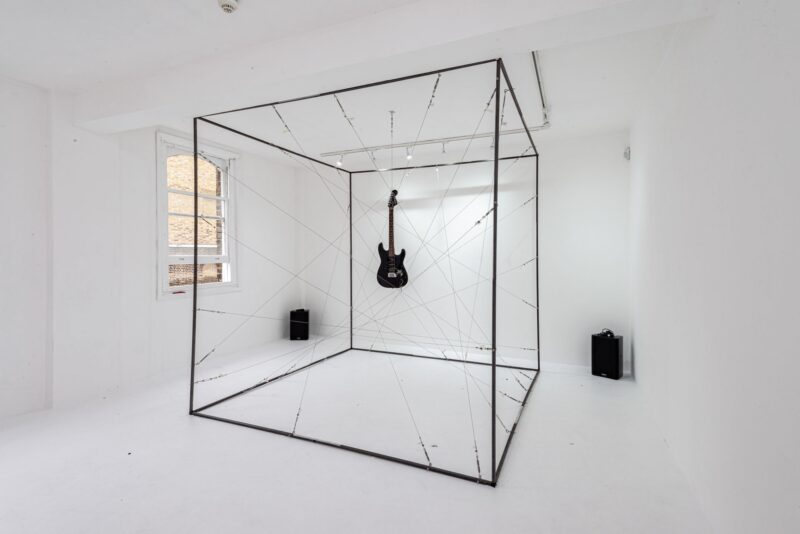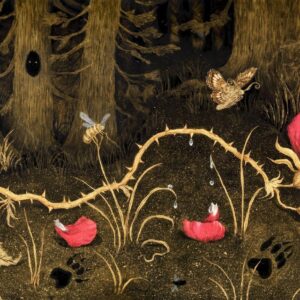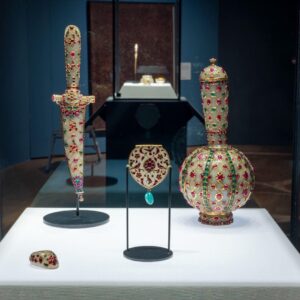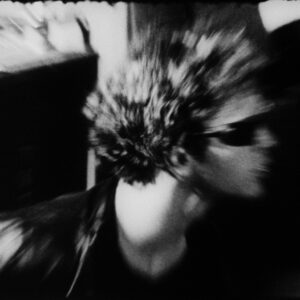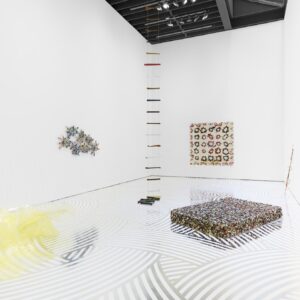More than seven years in the making, Epoh Beech’s hand-drawn animation sits at the heart of the exhibition. Inspired by Joseph Conrad’s novella, Heart of Darkness, and Ben Jonson’s Jacobean play ‘The Masque of Blackness’, it explores the geographical, historical and cultural relationship between the Thames and the Rhine, and between West Africa, England and Germany. Recurring characters and motifs featured in the animation and drawings include Shells, Hermes (the grey Seal), Pegasus (the mythological horse representing justice, wisdom and acting as a muse to the poets, unhindered by the straightjacket of history and time), Oil Rigs and water nymphs.
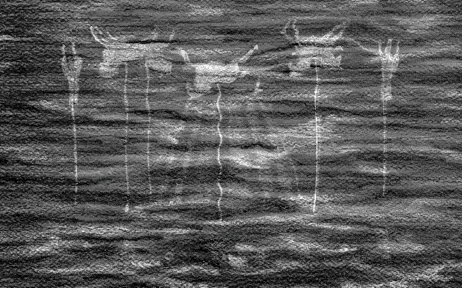
The film, edited by Matthew Thomas, features an original musical score by Esben Tjalve and choreography by Julia Gillespie to evoke a sense of place and spirit in the busy heart of London. A one-off 19th Century-style theatre room, with vintage theatre seats and red velvet curtains, will display the animation inside Gallery 46.
Accompanying the 12-minute film will be an extensive series of drawings and preparatory sketches of varying scale, detailing the journey of the painstakingly created animation. Beech meticulously hand draws the animations in charcoal or carbon on paper using a palimpsest technique – where images are created, partially erased and then redrawn repeatedly to create a multi-layered effect. To create just one second of animation requires 25 drawings, demonstrating the Herculean nature of this project.
Beech’s latest exhibition acts as a sequel to her 2010 “Marriage of the Thames and the Rhine”. Following the success of the original exhibition, Londonewcastle agreed to support the artist with sponsorship towards a projection of her latest work on the side of the national theatre fly tower.
Epoh Beech comments:
“This exhibition explores themes around time and transience, and the longevity of the project has allowed me to take a much more holistic approach to my research. It’s been a true labour of love, and I’ve produced thousands of drawings, too many to count, over a period of seven years spent in the studio and on field trips to the Rivers that inspired my work. Gallery 46 and the team at Londonewcastle have been hugely supportive, and I’m a big supporter of these types of exhibition spaces which support the capital’s artist community.”
Curated by Lee Sharrock, Epoh Beech’s “The Masque of Blackness” solo exhibition will run from 6th September to 6th October 2018 at Gallery 46 gallery46.co.uk Private View: Thurs 6th September 2018, 6pm – 9pm
In addition, The Masque of Blackness will also feature as a standalone projection on the side of the fly tower at the National Theatre every evening from 8pm – 11pm, 27th – 29th September, which has been established through Londonewcastle’s sponsorship and as part of the forthcoming Totally Thames. On the evening of Thursday 27th September, the looping animation will also be accompanied by a live musical performance from Esben Tjalve.
Totally Thames 2018- The Masque of Blackness by Epoh Beech Thurs 27th – Sat 29th September, 8pm – 11pm
National Theatre Flytower, Upper Ground SE1 9PX www.totallythames.org
About The Artist
Epoh Beech studied as a fine artist in Florence, at Cheltenham Art School and Chelsea College of Art. She has an MA in Art Therapy from the University of Hertfordshire and works out of the ACAVA studios in West London.
She has completed five major series of works, each follow a journey, tell a story, and illustrate a particular poem or Jacobean “Masque”. Each has been exhibited in either London or Oxford. The work is strongly influenced by the narrative force and the quest for the sublime through the balance of colour and light most evident in the work of 15th Italian Renaissance and German Romantic painters.
The recent series in animated drawing explores the relationship between still images, moving images and music. Beech hand draws the animations in charcoal on paper using a palimpsest technique, inspired by the animations of William Kentridge and the photography of Hiroshi Sugimoto. The depiction of darkness, shadows and black found in the etchings of Goya and Samuel Palmer, the drawings of George Seurat and the films of Lotte Reineger have greatly informed her practice. epohbeech.co.uk
About The Masque of Blackness
An exhibition of sculptures from West Africa ‘Kingdom of Life’ at the British Museum in 2010 was the initial trigger for the exhibition, which has come to fruition in 2018. Beech was moved by the refined sculptures from Ife, which is regarded today as the spiritual heartland of Nigeria’s Yoruba people. According to Nigerian mythology, Ife was the centre of creation of mankind and the world, and art historians consider it as the birthplace of some of the most accomplished African art.
After seeing the British Museum exhibition, Beech read Ben Jonson’s ‘The Masque of Blackness’, a mythological Jacobean play featuring the God of the river Niger in conversation with the Moon and the Ocean. She was also inspired by Francis Beaumont’s Jacobean novel the “Marriage of the Thames and Rhine”, and Joseph Conrad’s 19th Century novella about the Congo River, “Heart of Darkness”. She began to explore the relationship between Africa and Germany (the Niger and Rhine rivers), and embarked upon a 7-year journey of research including a field trip to sketch mangroves in Ghana, and an arts residency in The Netherlands (North Rhine – Westphalia), in an old watchtower by the Rhine on the Dutch / German border, where she spent 3 weeks looking at the river, eventually culminating in the Gallery 46 solo exhibition. Other artist residencies include a month in Berlin in 2006, and the ‘Telpost Millingen aan de Rijn’ Residency by the Rhine on the Dutch /German boarder in 2014. Such is Beech’s obsession with studying the Rhine’s history and documenting it through her art, she has been walking the length of the Rhine from the source on and off since 2004.
In 1605 ‘The Masque of Blackness’ was performed as a pageant on the River Thames opposite the Shell Building (Royal Dutch Shell Company has been drilling for oil in the Niger Delta, Nigeria since 1956). Beech’s devotion to her subject meant that she contacted Julia Gillespie at the Ballet Rambert, who posed for her as Oya, the Yoruba Goddess of the Niger coming out of the shell.
Joseph Conrad’s Novella ‘Heart of Darkness’ was published more than a century ago yet it continues to inspire artists, writers and musicians to this day as a defining work of literature, and Epoh Beech is one of them. ‘Heart of Darkness’ takes place one evening on a boat on the River Thames, explores one man’s search for another, and was inspired by the author’s violent experience of colonialism in the Congo. One of the characters featured in Beech’s animation is a binocular-wielding man, inspired by the anonymous narrator on board ‘The Nellie’ in ‘Heart of Darkness’.
The other defining work of literature which runs through the narrative of Beech’s animation and accompanying drawings is Ben Jonson’s ‘The Masque of Blackness’, which was commissioned by King James I’s wife, Anne of Denmark, The water nymphs featured in the story were played by Queen Anne and her ladies in waiting, who emerged from a giant seashell before actors playing Gods appeared: Oceanus (god of the Atlantic Ocean) and Niger (the god of the Niger River in Africa and son of Oceanus). Niger explains to Oceanus that his daughters are Ethiopian water nymphs, who changed the course of the river Niger at their request. The stage set, costumes and stage effects for ‘The Masque of Blackness’ were designed by Inigo Jones, who also designed the Queen’s House in Greenwich for James I‘s wife Queen Anne.
In the early 17th Century when the Masque was written, the European discovery of the New World and global expansion into Africa was a very recent phenomenon. The term masque refers to a specific type of play combining song, dance, poetry and elaborate staging and costumes, which were written predominately in the early part of the 17th century. Masques were performed for Royalty and the upper echelons of English society on special occasions like holidays or days of state, and only for the very upper level of English society, mainly the King and the court.
Through the drawings and animation, Epoh Beech reimagines and weaves together the literary works of ‘The Masque of Blackness’ (1605) where the Niger River is protagonist, and Joseph Conrad’s journey up the Congo in ‘Heart of Darkness’ (1899). The exhibition examines the relationship Thames and West African rivers, in particular, the Niger, Congo, Volta and Ankobra rivers. The artist has spent many days walking and drawing by the banks of these rivers, both physically and in her imagination. ‘Heart of Darkness’ is narrated at dusk, by an anonymous narrator, who is a crew member on board a boat (yawl) called ‘The Nellie’. This yawl is moored at Gravesend on the Thames at dusk. There is a link between the Thames and West African rivers and the imagination as a metaphor for unexplored territory, the unknown. Conrad’s use of frame narrative (story within a story) in ‘Heart of Darkness’ is also used in Epoh Beech’s animation.
About Londonewcastle
Londonewcastle has created developments in the capital for the design-conscious for the past three decades. Their core belief is to bring outstanding architecture to mixed-use developments, delivering the highest quality buildings, public realms and cultural destinations.
Londonewcastle is currently building in 8 different London boroughs, with plans to deliver over 2,000 new homes across London in the next 5 years. Projects range from area regeneration, listed building restoration, affordable homes, the public realm to education-led residential masterplans. Londonewcastle is committed to supporting contemporary art since its inception, both for established and emerging artists in London and internationally.
About Gallery 46
Gallery 46 is a Londonewcastle project space run in association with Martin J Tickner, Sean McLusky and Fruitmachine founders, Martin Bell and Wai Jung Young. The venue is continuing the legacy of Tickner and Mclusky’s previous gallery, MEN on Redchurch Street Shoreditch London.
Gallery 46, housed in a pair of renovated Georgian houses in the grounds of Whitechapel Hospital and set over three floors and eight rooms is a kaleidoscopic addition to Whitechapel’s burgeoning gallery scene and its artistic heart, the nearby Whitechapel Gallery. Since it opened in October 2016, the gallery has hosted works by artists such as Iain Sinclair and Eley Kishimoto as well as successful exhibitions such as their first show, Autonomy.



